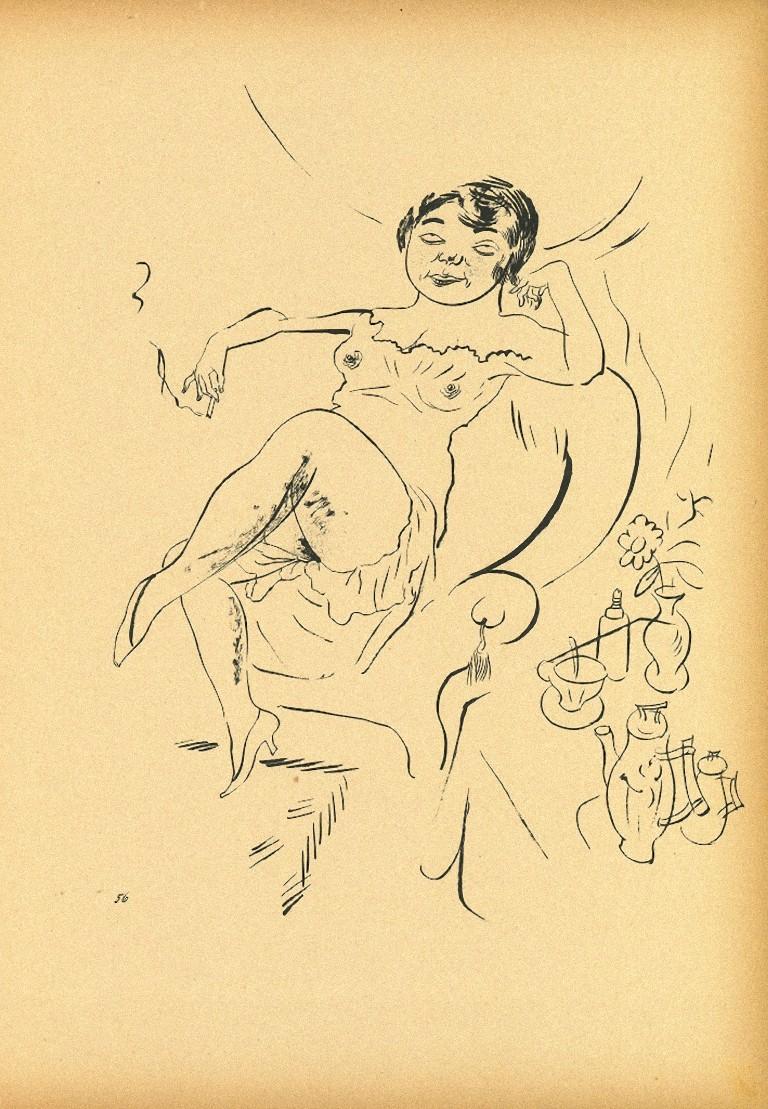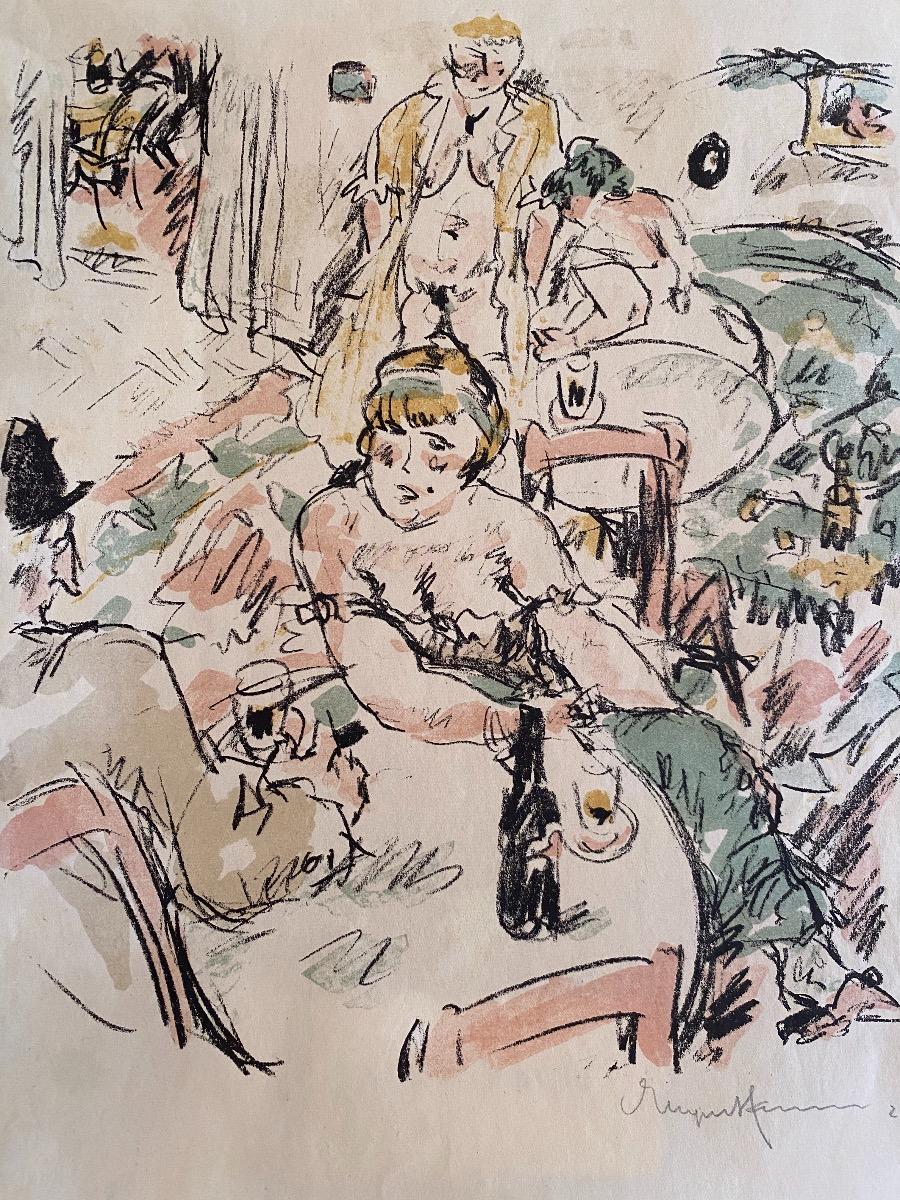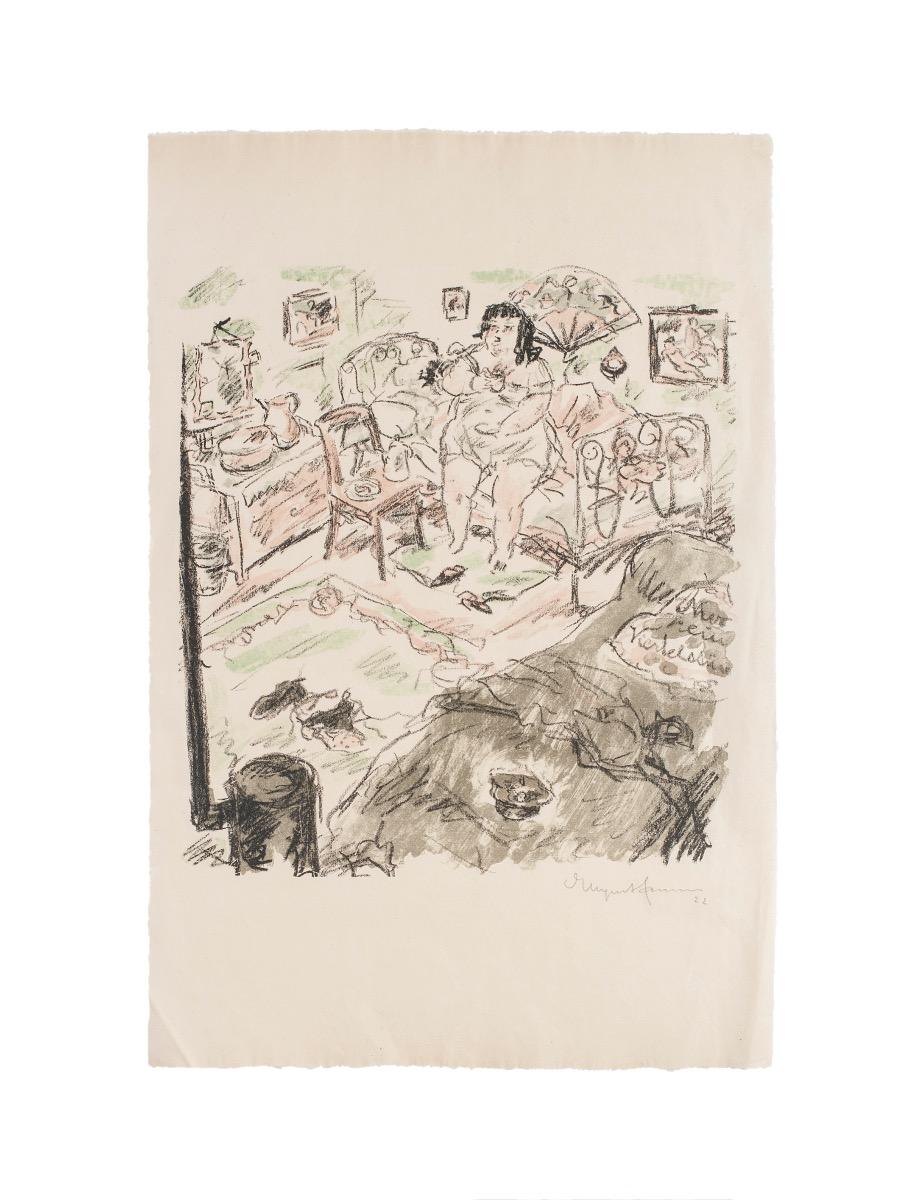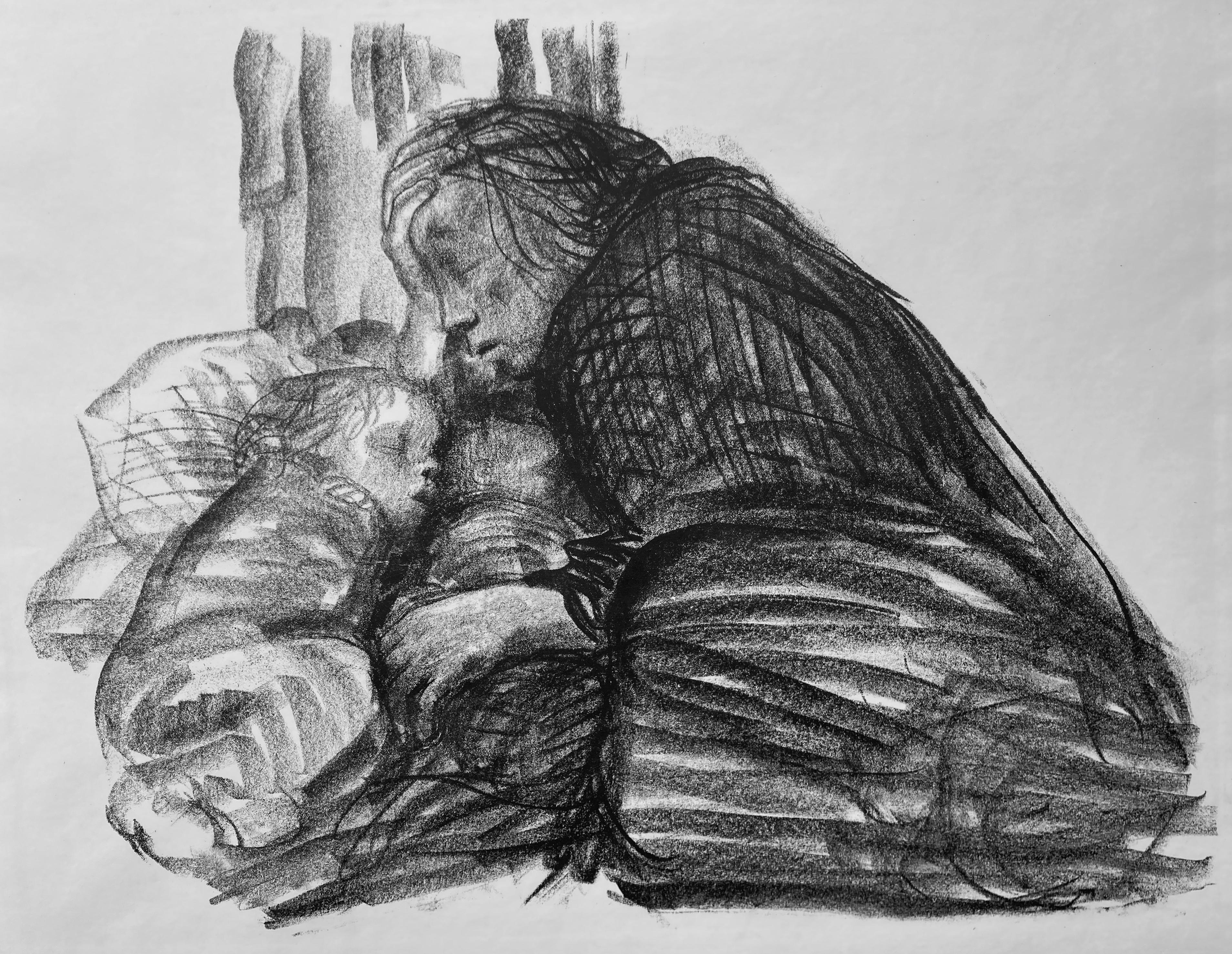Items Similar to untitled (Woman with Hands on Hips)
Want more images or videos?
Request additional images or videos from the seller
1 of 6
Rudolf Baueruntitled (Woman with Hands on Hips)c. 1910's
c. 1910's
About the Item
untitled (Woman with Hands on Hips)
Lithograph on tan wove paper, c. 1910's
Signed in pencil lower right and in the plate, lower right
(see photo)
Edition: c. 100
Condition: Excellent
Image size: 11-1/4 x 4-1/2 inches
Sheet size: 18 1/8 x 11 3/8 inches
Provenance: Estate of the Artist
Borghi & Company, New York
Herb Lerner, Boca Raton, FL
Rudolph Bauer
1889-1953
Rudolf Bauer was born in Lindenwald near Bromberg, Silesia, in 1889 but his family moved only a few years later to Berlin. In 1905 Bauer began his studies at the Berlin Academy of Art but left the Academy only a few months later to educate himself. The upshot was paintings, caricatures and comical drawings which were published in 'Berliner Tageblatt', 'Ulk' and 'Le Figaro'.
From 1912 Bauer contributed to the magazine and Gallery 'Der Sturm' founded by Herwarth Walden and pivotal to German Expressionism and the international avant-garde. In 1915 Rudolf Bauer participated for the first time in a group show at Walden's gallery. There he met Hilla von Rebay, with whom he began a relationship of many years that was crucial to Bauer's later work. By 1922 Bauer had shown work at about eight exhibitions mounted by 'Der Sturm'. From 1918 he also taught at the 'Der Sturm' art school, where Georg Muche was the director. After the war ended, Bauer was a founding member of the 'November Group' although he did not collaborate closely with the group. In 1919 Bauer joined forces with the painter and architect Otto Nebel and with Hilla von Rebay to found the artists' association 'Die Krater'. Impressionist at the outset, Bauer's early work reveals Cubist and Expressionist influences. By 1915/16 Bauer had switched to an abstract pictorial idiom, which is markedly influenced by Kandinsky. In the early 1920s Bauer was also preoccupied with Russian Constructivism as well as the Dutch de Stijl group. Bauer's decided preference for non-representational painting culminated in 1929 with the foundation of a private museum, 'Das Geistreich', which he directed as a salon for abstract art.
Political developments in Germany forced Bauer to sell some of his work in America from 1932. His agent in America was Hilla von Rebay, who was by now director of the Guggenheim Collection. In 1936 she organized a touring exhibition of non-representational European art that included sixty Rudolf Bauer oil paintings and watercolors. After Rudolf Bauer emigrated to the US in 1939, his work was exhibited several times at the Guggenheim Foundation before his death in 1953. Rudolf Bauer's comprehensive œuvre, which had been consigned to virtual oblivion after 1960 in both the US and Europe, has been enjoying a renaissance of interest worldwide since the 1980s.
Courtesy: www.Rudolph-Bauer
- Creator:Rudolf Bauer (1889-1953, German)
- Creation Year:c. 1910's
- Dimensions:Height: 11.25 in (28.58 cm)Width: 4.5 in (11.43 cm)
- Medium:
- Movement & Style:
- Period:
- Condition:
- Gallery Location:Fairlawn, OH
- Reference Number:
Rudolf Bauer
The true story of Rudolf Bauer is perhaps one of the most complex, tragic, and ironic of 20th century art history. Rudolf Bauer was a pioneering German-born artist who, along with Vasily Kandinsky, was among the first abstract artists in the world. His “non-objective” abstract style would go on to influence virtually all aspects of modern art and serve as a beacon to Pollock, Rothko, and other artists who formed the New York school of Abstract Expressionism. In the first half of the 20th century, Bauer’s works were displayed alongside such luminaries as Picasso, Chagall, Miró, Mondrian, and Kandinsky, in numerous galleries and museums throughout the world. However by the end of World War II, Bauer had stopped painting and fell into obscurity.
About the Seller
5.0
Recognized Seller
These prestigious sellers are industry leaders and represent the highest echelon for item quality and design.
Platinum Seller
These expertly vetted sellers are 1stDibs' most experienced sellers and are rated highest by our customers.
Established in 1978
1stDibs seller since 2013
716 sales on 1stDibs
Typical response time: 1 hour
Associations
International Fine Print Dealers Association
- ShippingRetrieving quote...Ships From: Akron, OH
- Return PolicyA return for this item may be initiated within 10 days of delivery.
More From This SellerView All
- Circle of LifeBy Rudolf BauerLocated in Fairlawn, OHCircle of Life Lithograph on tan paper, c. 1910's Signed in pencil lower right; signed in the plate lower right (see photo) Annotated "No. 50" in pencil lower left (see photo) Provenance: Estate of the artist Borghi & Company, New York Herb Lerner, Boca Raton, FL Condition: Excellent Image size: 11-3/4 x 17-1/2 inches Sheet size: 19 x 22 1/2 inches Rudolph Bauer 1889-1953 Rudolf Bauer was born in Lindenwald near Bromberg, Silesia, in 1889 but his family moved only a few years later to Berlin. In 1905 Bauer began his studies at the Berlin Academy of Art but left the Academy only a few months later to educate himself. The upshot was paintings, caricatures and comical drawings which were published in 'Berliner Tageblatt', 'Ulk' and 'Le Figaro'. From 1912 Bauer contributed to the magazine and Gallery 'Der Sturm' founded by Herwarth Walden and pivotal to German Expressionism and the international avant-garde. In 1915 Rudolf Bauer participated for the first time in a group show at Walden's gallery. There he met Hilla von Rebay, with whom he began a relationship of many years that was crucial to Bauer's later work. By 1922 Bauer had shown work at about eight exhibitions mounted by 'Der Sturm'. From 1918 he also taught at the 'Der Sturm' art school, where Georg Muche was the director. After the war ended, Bauer was a founding member of the 'November Group' although he did not collaborate closely with the group. In 1919 Bauer joined forces with the painter and architect Otto Nebel and with Hilla von Rebay to found the artists' association 'Die Krater'. Impressionist at the outset, Bauer's early work reveals Cubist and Expressionist influences. By 1915/16 Bauer had switched to an abstract pictorial idiom, which is markedly influenced by Kandinsky. In the early 1920s Bauer was also preoccupied with Russian Constructivism as well as the Dutch de Stijl group. Bauer's decided preference for non-representational painting culminated in 1929 with the foundation of a private museum, 'Das Geistreich', which he directed as a salon for abstract art. Political developments in Germany forced Bauer to sell some of his work in America from 1932. His agent in America was Hilla von Rebay, who was by now director of the Guggenheim Collection. In 1936 she organized a touring exhibition of non-representational European art that included sixty Rudolf Bauer oil...Category
1910s Expressionist Figurative Prints
MaterialsLithograph
- For LisaBy Willem de KooningLocated in Fairlawn, OHFor Lisa Color lithograph, 1984 Signed in pencil lower left (see photo) Numbered lower right corner Published to benefit the Los Angeles Children's Museum Printed by Brand X Editions...Category
1980s Expressionist Figurative Prints
MaterialsLithograph
- Four End GirlsBy Adolf DehnLocated in Fairlawn, OHLithograph, 1930 Edition: 20; this print numbered 9/20 Printed by Meister Schulz, Berlin Excellent condition Signed, numbered and titled in pencil Provenance: Estate of the Artist Cr...Category
1930s Expressionist Figurative Prints
MaterialsLithograph
- Die Bettler (The Beggars)By Max BeckmannLocated in Fairlawn, OHDie Bettler (The Beggars) Lithograph, 1922 Signed in pencil lower right (see photo) From: Berliner Reise Series, Plate 7 Printed on wove paper Edition: 100...Category
1920s Expressionist Figurative Prints
MaterialsLithograph
- Plate 12By Wassily KandinskyLocated in Fairlawn, OHPlate 12 From: 10 Origi, 1942 Signed in the block with the artist's initials lower left (printed) From: 10 Origin Not from the First edition 100, published by Allianz-Verlag, Zurich,...Category
1970s Expressionist Abstract Prints
MaterialsWoodcut
- Le monocycle (Performer on a Unicycle)By Bernard BuffetLocated in Fairlawn, OHLe monocycle (Performer on a Unicycle) Color lithograph, 1968 Signed and numbered in pencil lower left corner From the portfolio "Mon Cirque" (My Circus) Edition: 120 (12/120) Reference: Sorlier, Buffet Lithographs, No. 166 Condition: Excellent Image size: 26 3/4 x 18 1/2 inches Sheet size: 28 1/4 x 20 inches Provenance: Robert Henry Adams, Chicago From Wikipedia, the free encyclopedia Bernard Buffet Born 10 July 1928 Paris, France Died 4 October 1999 (aged 71) Nationality French Education École Nationale Supérieure des Beaux-Arts, Marie-Thérèse Auffray Known for Painting, Drawing, Printmaking Movement Expressionism Awards Member of the Salon d'Automne, 1947 Member of the Société des Artistes Indépendants, 1947 Prix de la Critique, 1948 Prix Puvis de Chavannes, 1950 Officer of the Légion d'Honneur,1973 Member of the Académie des Beaux-Arts, 1974 Bernard Buffet (French: [byfɛ]; 10 July 1928 – 4 October 1999) was a French painter, printmaker, and sculptor. He produced a varied and extensive body of work. His style was exclusively figurative. The artist enjoyed worldwide popularity early in his career but was shunned by art pundits later on. Today, there is a renewed interest in Bernard Buffet's oeuvre. His works can be seen in the collections of the world's leading museums, including the Musée d'Art Moderne de Paris, the Tate, and the Museum of Modern Art. Biography Bernard Buffet was born in 1928. He hailed from a middle-class family with roots in Northern and Western France. His spent his childhood in Paris. His mother often took him to the Louvre Museum, where he got familiar with the works of Realist painters, such as Gustave Courbet. This is likely to have influenced his style. In 1955, he painted a work that paid tribute to Courbet's Le Sommeil. Bernard Buffet was a student at the Lycée Carnot during the Nazi occupation of Paris. He travelled to drawings courses in the evenings despite the curfew imposed by the Nazi authorities. He then studied art at the École Nationale Supérieure des Beaux-Arts (National School of the Fine Arts) and worked in the studio of the painter Eugène Narbonne. Among his classmates were Maurice Boitel and Louis Vuillermoz. He met the French painter Marie-Thérèse Auffray and was influenced by her work. Buffet's mother, Blanche, died from breast cancer in 1945. Seventeen-year-old Buffet...Category
1960s French School Figurative Prints
MaterialsLithograph
You May Also Like
- General from Ecce Homo - Original Offset and Lithograph by George Grosz - 1923By George GroszLocated in Roma, ITGeneral from Ecce Homo is an original offset and lithograph realized by George Grosz. The artwork is the plate n. 55 from the portfolio Ecce Homo published between 1922/1923, editio...Category
1920s Expressionist Figurative Prints
MaterialsOffset, Lithograph
- Woman from Ecce Homo - Original Offset and Lithograph by George Grosz - 1923By George GroszLocated in Roma, ITWoman from Ecce Homo is an original offset and lithograph realized by George Grosz. The artwork is the plate n. 56 from the porfolio Ecce Homo published between 1922/1923, edition o...Category
1920s Expressionist Figurative Prints
MaterialsOffset, Lithograph
- In the Brothel - Original Lithograph by Eugen Hamm - 1922Located in Roma, ITIn the Brothel is an original lithograph realized by Eugen Hamm a german artist in 1922. In good conditions. This artwork represents a brothel with severa...Category
1920s Expressionist Figurative Prints
MaterialsLithograph
- In the Brothel - Original Lithograph by Eugen Hamm - 1922Located in Roma, ITIn the Brothel is an original lithograph realized by Eugen Hamm in 1922. In good conditions. This artwork represents a brothel with several nude women. H...Category
1920s Expressionist Figurative Prints
MaterialsLithograph
- In the Brothel - Original Lithograph by Eugen Hamm - 1922Located in Roma, ITIn the Brothel is an original lithograph realized by Eugen Hamm in 1922. In good conditions. This artwork represents a brothel with several nude women. H...Category
1920s Expressionist Figurative Prints
MaterialsLithograph
- STADTISCHES OBDACH (Urban Shelter)By Käthe KollwitzLocated in Santa Monica, CAKATHE KOLLWITZ (German 1867 -1945) STADTISCHES OBDACH (Urban Shelter) 1926 (Knesebeck 226, Klipstein 219.bB), Lithograph from the unsigned edition for the annual edition of the Kuns...Category
1920s Expressionist Figurative Prints
MaterialsLithograph






